Traditionalist Issues
 |
 |
 |
 |
 |
 |
 |
Dialogue Mass - LXXVII
‘The Faithful Have Consecratory Power’
Who are the “true actors” (1) in the liturgy? Before the Liturgical Movement, the answer was dazzlingly clear from the way Mass was performed by the priest with the assistance of his ministers at the altar, while the congregation, suitably separated from the sanctuary, participated spiritually in prayerful silence.
But the liturgical reformers, who assiduously promoted the notion that the whole assembly performs the liturgy, have used this falsity – borrowed from Protestantism – to impugn the special status that is essential to protect the integrity of the ordained priesthood.
To bring these two positions – Catholic and Protestant – into sharper focus, it will be illuminating to juxtapose two commentaries on lay participation, the first written before the start of the Liturgical Movement by the English Redemptorist, Fr. Thomas Edward Bridgett, (2) who described the Mass as essentially a divine action, and the second by a post-Vatican II priest of the Archdiocese of Washington, Fr. Robert Duggan, who presented it as the work of the people.
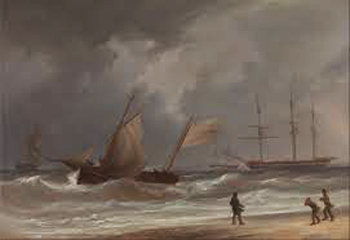 First, Fr. Bridgett’s explanation:
First, Fr. Bridgett’s explanation:
“Suppose a ship, filled with a mixed crew of French, Spanish and Portuguese, is being wrecked on the coast of England. A crowd is assembled on the cliff, watching with intense earnestness the efforts being made by the captain and crew on the one hand, and by lifeboats from the coast on the other, to save the lives of the passengers. A great act is being performed, in which all are taking part, some as immediate actors, others as eager assistants. …
"It is a common act at which they assist; it is accompanied by the prayers of all; but they are not common prayers, in the sense of all joining either vocally or mentally in the same form of words.” [emphasis added] (3)
We have to admire the use of this memorable analogy between the action of the Mass and the life-saving work of a rescue operation, insofar as it illustrates who the “true actors” really are.
The captain of the ship is obviously meant to evoke the priest, for on his shoulders alone devolves the whole responsibility for the Mass, while the assisting crew and lifeboat operators represent his ministers in the sanctuary.
The people on the shore, powerless to intervene in the action, represent the congregation in the pews who have no active role in the Mass because they lack the power to re-enact the Holy Sacrifice or officiate at its ceremonies. Nevertheless, they participate spiritually by offering their own heartfelt prayers without, however, any obligation to follow the priest’s prayers either silently or audibly, or to engage in vocal dialogue with him.
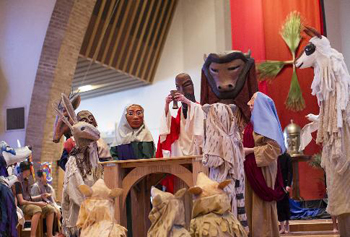 As Fr. Bridgett explained:
As Fr. Bridgett explained:
“To join in this act of sacrifice, and to participate in its effects, it is not necessary to follow the priest or to use the words he uses. Every Catholic knows what the priest is doing, though he may not know or understand what he is saying, and is consequently able to follow with his devotions every portion of the Holy Sacrifice. Hence, a wonderful union of sacrificial, of congregational and of individual devotion.”
Of course, there was no need to spell any of this out to Catholics of the 19th century. Fr. Bridgett was writing in defence of the Mass against the prejudices of contemporary Protestants who, ironically, were making the same gibes against Catholic worship as the progressivists of the 20th century would do.
He was addressing the Protestant charges of “clericalism” – that the people were “excluded” from participation in the proceedings because their rightful roles were usurped by the priest; that they were prevented from understanding what was going on by the “language barrier,” and so on and ridiculously on.
What was Vatican II’s response to this “a wonderful union of sacrificial, of congregational, and of individual devotion”?
Its Liturgy Constitution set out to denounce it, in carefully coded terms, as a recipe for alienating the faithful and introduce, instead, liturgical reforms to “rectify” the problem through “active participation.” This “solution” (to a problem, let us remember, that never existed) was presented as if it were an article of faith and the highest state of grace to which the faithful could attain.
‘Active participation’ leads to a misunderstanding of the priesthood
For our second commentary on lay participation in the Mass, we will fast forward to the post-Vatican II period when the reformers were given a free pass to recreate the liturgy in their own ideological image. Fr. Robert Duggan comments on the role of the faithful at the Mass:
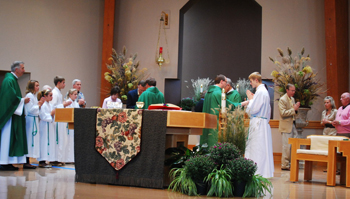 “It is they ‒ just as much as the presider ‒ who must offer the great sacrifice of praise and thanksgiving to God; it is they ‒ just as much as the presider ‒ who carry responsibility to say the prayers and sing the songs prescribed for them in the ritual texts; it is they ‒ just as much as the presider ‒ who must be channels of the Spirit’s consecratory power, allowing the gift of themselves to be transformed as surely as the gifts of bread and wine are changed into Christ’s body and blood.” (4)
“It is they ‒ just as much as the presider ‒ who must offer the great sacrifice of praise and thanksgiving to God; it is they ‒ just as much as the presider ‒ who carry responsibility to say the prayers and sing the songs prescribed for them in the ritual texts; it is they ‒ just as much as the presider ‒ who must be channels of the Spirit’s consecratory power, allowing the gift of themselves to be transformed as surely as the gifts of bread and wine are changed into Christ’s body and blood.” (4)
It is obvious that the two ways of understanding the liturgy are poles apart, and even stand in opposition to each other. The Novus Ordo Mass was conceived by the reformers as the “work of the people,” a community act in which all present are equally entitled to their share of “active participation,” without distinction of whether they are clerical or lay.
The dark underbelly of the progressivists’ dream
This subversive power-to-the-people message is perfectly encapsulated in the teaching of the Liturgy Constitution §28, which states:
“In liturgical celebrations each one, minister or layperson, who has an office to perform, should do all of, but only, those parts which pertain to that office by the nature of the rite and the principles of the liturgy.”
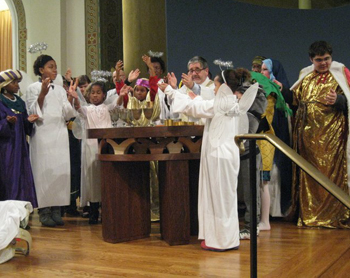 In making such a statement, the reformers revealed their covert plans to Protestantize the liturgy. For, it subtly suggests that Catholic worship is simply and solely a joint enterprise between the priest and the people in which the latter have an essential liturgical office to perform – a proposition condemned by the Council of Trent.
In making such a statement, the reformers revealed their covert plans to Protestantize the liturgy. For, it subtly suggests that Catholic worship is simply and solely a joint enterprise between the priest and the people in which the latter have an essential liturgical office to perform – a proposition condemned by the Council of Trent.
This intention was confirmed by Fr. Ralph Wiltgen in an interview with one of the Council’s Bishops immediately before the final vote on the Liturgy Constitution (1963):
“Bishop Zauner [of Linz, Austria] told me that four important aims or principles were reflected in the Constitution on the Sacred Liturgy. “The first is that divine worship must be a community action; that is, that the priest should do everything with the active participation of the people, and never alone.” The use of the vernacular, he said, was a necessary condition for such participation. [emphasis added] (5)
What could be more calculated to make the priest appear “one of the people” than to have all speak and act in a common enterprise? This had been the cherished aim of the Liturgical Movement from Beauduin to Vatican II and remains the underlying major premise of the Novus Ordo.
‘The rising tide lifts all boats’
Here we will consider how the reformers’ aim to “narrow the gap” between the clergy and the laity was realized in practice. The revolutionary tide of Vatican II artificially raised all the faithful to the status of “true actors” in the liturgy, giving them equal rights to the clergy, by virtue of their common Baptism, “to perform some particular ministry or function in the celebration.” (6)
But, if all the members of the assembly, including the priest, have their own special responsibility in the enactment of the Mass, there is nothing particularly unique about the status of priests.
As the Grand Inquisitor sang in Gilbert and Sullivan’s Opera, “When everybody’s somebody, then no one’s anybody.” (7) As a result, the only person who is “somebody” in the Mass (i.e. the one who stands in the place of Christ) ends up as “nobody” special in the eyes of the assembly. That would negate the whole point of treating priests as a separate and higher category, capable of exercising power and authority in spiritual matters over the laity.
A disguised attack on the priesthood
However, the Orwellian language of Progressivism has disguised this radical rearrangement of roles as humility and generosity on the part of the modern clergy. They pretend that the Church has been guilty of “clericalism” for most of her History in “excluding” the laity from “active participation,” and that they must make amends for past “injustices.”
Uniquely among all religions, the Mass, the ministerial priesthood and the role of both in the salvation of souls are all indissolubly linked. Attacking any one of these three elements, as Luther knew full well, is to attack Catholicism itself. Thus, with the imposition of the Novus Ordo reform which apes the language and customs of Protestantism, the attack from without was hugely reinforced by the attack from within.
Continued

But the liturgical reformers, who assiduously promoted the notion that the whole assembly performs the liturgy, have used this falsity – borrowed from Protestantism – to impugn the special status that is essential to protect the integrity of the ordained priesthood.
To bring these two positions – Catholic and Protestant – into sharper focus, it will be illuminating to juxtapose two commentaries on lay participation, the first written before the start of the Liturgical Movement by the English Redemptorist, Fr. Thomas Edward Bridgett, (2) who described the Mass as essentially a divine action, and the second by a post-Vatican II priest of the Archdiocese of Washington, Fr. Robert Duggan, who presented it as the work of the people.

The people on shore are powerless to save a capsizing ship
“Suppose a ship, filled with a mixed crew of French, Spanish and Portuguese, is being wrecked on the coast of England. A crowd is assembled on the cliff, watching with intense earnestness the efforts being made by the captain and crew on the one hand, and by lifeboats from the coast on the other, to save the lives of the passengers. A great act is being performed, in which all are taking part, some as immediate actors, others as eager assistants. …
"It is a common act at which they assist; it is accompanied by the prayers of all; but they are not common prayers, in the sense of all joining either vocally or mentally in the same form of words.” [emphasis added] (3)
We have to admire the use of this memorable analogy between the action of the Mass and the life-saving work of a rescue operation, insofar as it illustrates who the “true actors” really are.
The captain of the ship is obviously meant to evoke the priest, for on his shoulders alone devolves the whole responsibility for the Mass, while the assisting crew and lifeboat operators represent his ministers in the sanctuary.
The people on the shore, powerless to intervene in the action, represent the congregation in the pews who have no active role in the Mass because they lack the power to re-enact the Holy Sacrifice or officiate at its ceremonies. Nevertheless, they participate spiritually by offering their own heartfelt prayers without, however, any obligation to follow the priest’s prayers either silently or audibly, or to engage in vocal dialogue with him.

'Performers' acting out the Christmas scene in costume at the 'new Mass,' in contrast with the sacrality that was present in the Masses of the past
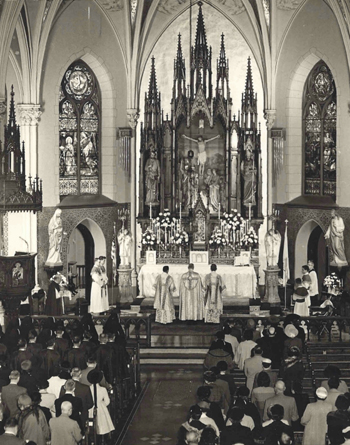
“To join in this act of sacrifice, and to participate in its effects, it is not necessary to follow the priest or to use the words he uses. Every Catholic knows what the priest is doing, though he may not know or understand what he is saying, and is consequently able to follow with his devotions every portion of the Holy Sacrifice. Hence, a wonderful union of sacrificial, of congregational and of individual devotion.”
Of course, there was no need to spell any of this out to Catholics of the 19th century. Fr. Bridgett was writing in defence of the Mass against the prejudices of contemporary Protestants who, ironically, were making the same gibes against Catholic worship as the progressivists of the 20th century would do.
He was addressing the Protestant charges of “clericalism” – that the people were “excluded” from participation in the proceedings because their rightful roles were usurped by the priest; that they were prevented from understanding what was going on by the “language barrier,” and so on and ridiculously on.
What was Vatican II’s response to this “a wonderful union of sacrificial, of congregational, and of individual devotion”?
Its Liturgy Constitution set out to denounce it, in carefully coded terms, as a recipe for alienating the faithful and introduce, instead, liturgical reforms to “rectify” the problem through “active participation.” This “solution” (to a problem, let us remember, that never existed) was presented as if it were an article of faith and the highest state of grace to which the faithful could attain.
‘Active participation’ leads to a misunderstanding of the priesthood
For our second commentary on lay participation in the Mass, we will fast forward to the post-Vatican II period when the reformers were given a free pass to recreate the liturgy in their own ideological image. Fr. Robert Duggan comments on the role of the faithful at the Mass:

A whole array of ministers assist the priest on the altar
It is obvious that the two ways of understanding the liturgy are poles apart, and even stand in opposition to each other. The Novus Ordo Mass was conceived by the reformers as the “work of the people,” a community act in which all present are equally entitled to their share of “active participation,” without distinction of whether they are clerical or lay.
The dark underbelly of the progressivists’ dream
This subversive power-to-the-people message is perfectly encapsulated in the teaching of the Liturgy Constitution §28, which states:
“In liturgical celebrations each one, minister or layperson, who has an office to perform, should do all of, but only, those parts which pertain to that office by the nature of the rite and the principles of the liturgy.”

Children in costumes raise their hands with the priest at the offertory
This intention was confirmed by Fr. Ralph Wiltgen in an interview with one of the Council’s Bishops immediately before the final vote on the Liturgy Constitution (1963):
“Bishop Zauner [of Linz, Austria] told me that four important aims or principles were reflected in the Constitution on the Sacred Liturgy. “The first is that divine worship must be a community action; that is, that the priest should do everything with the active participation of the people, and never alone.” The use of the vernacular, he said, was a necessary condition for such participation. [emphasis added] (5)
What could be more calculated to make the priest appear “one of the people” than to have all speak and act in a common enterprise? This had been the cherished aim of the Liturgical Movement from Beauduin to Vatican II and remains the underlying major premise of the Novus Ordo.
‘The rising tide lifts all boats’
Here we will consider how the reformers’ aim to “narrow the gap” between the clergy and the laity was realized in practice. The revolutionary tide of Vatican II artificially raised all the faithful to the status of “true actors” in the liturgy, giving them equal rights to the clergy, by virtue of their common Baptism, “to perform some particular ministry or function in the celebration.” (6)
But, if all the members of the assembly, including the priest, have their own special responsibility in the enactment of the Mass, there is nothing particularly unique about the status of priests.
As the Grand Inquisitor sang in Gilbert and Sullivan’s Opera, “When everybody’s somebody, then no one’s anybody.” (7) As a result, the only person who is “somebody” in the Mass (i.e. the one who stands in the place of Christ) ends up as “nobody” special in the eyes of the assembly. That would negate the whole point of treating priests as a separate and higher category, capable of exercising power and authority in spiritual matters over the laity.
A disguised attack on the priesthood
However, the Orwellian language of Progressivism has disguised this radical rearrangement of roles as humility and generosity on the part of the modern clergy. They pretend that the Church has been guilty of “clericalism” for most of her History in “excluding” the laity from “active participation,” and that they must make amends for past “injustices.”
Uniquely among all religions, the Mass, the ministerial priesthood and the role of both in the salvation of souls are all indissolubly linked. Attacking any one of these three elements, as Luther knew full well, is to attack Catholicism itself. Thus, with the imposition of the Novus Ordo reform which apes the language and customs of Protestantism, the attack from without was hugely reinforced by the attack from within.
Continued
- This expression came from a conference given in 2005 by Fr. Carlo Braga, a former member of Pius XII’s Liturgy Commission, to mark the 50th anniversary of Pius XII’s Holy Week reforms. See here.
- Fr. Bridgett, a convert to Catholicism, was a missionary priest and retreat master who spent most of his life defending the Faith against Protestant prejudices. Among his voluminous writings is Our Lady's Dowry; or, How England gained and lost that title; a Compilation (1875,) in which he defended medieval devotion to the Blessed Virgin and deftly rebutted all the Protestant charges of “idolatry.” (See here)
- T. E. Bridgett, CSSR, Ritual of the New Testament: An Essay on the Principles and Origin of Catholic Ritual in Reference to the New Testament, London, Burns and Oates, 1878, pp. 112-113.
- Fr. Robert Duggan, ‘Good Liturgy: The Assembly.’ America Magazine, with an Introduction by Fr. James Martin SJ, 1 March 2004
- Ralph Wiltgen, SVD, The Rhine Flows into the Tiber: The Unknown Council, New York, Hawthorn Books, 1967, p. 137.
- General Instruction of the Roman Missal (2010) § 97.
- Quote from the Gilbert and Sullivan Opera, The Gondoliers, which satirizes the promoters of social equality who “abhor kings ... detest rank [and] despise wealth.” The Grand Inquisitor, Don Alhambra, an opponent of social levelling, holds that traditional distinctions between rulers and their subjects, between masters and servants, must be maintained for the proper order of society.

Posted October 10, 2018
______________________
______________________
 Volume I |
 Volume II |
 Volume III |
 Volume IV |
 Volume V |
 Volume VI |
 Volume VII |
 Volume VIII |
 Volume IX |
 Volume X |
 Volume XI |
 Special Edition |


